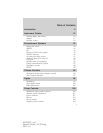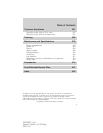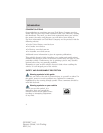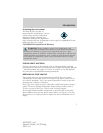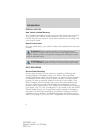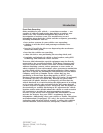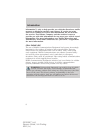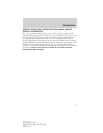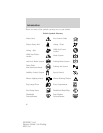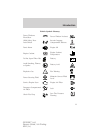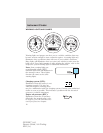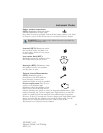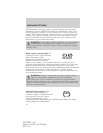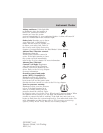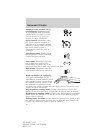
Event Data Recording
Other modules in your vehicle — event data recorders — are
capable of collecting and storing data during a crash or near
crash event. The recorded information may assist in the
investigation of such an event. The modules may record
information about both the vehicle and the occupants, potentially
including information such as:
• how various systems in your vehicle were operating;
• whether or not the driver and passenger seatbelts were
buckled;
• how far (if at all) the driver was depressing the accelerator
and/or the brake pedal;
• how fast the vehicle was traveling;
• where the driver was positioning the steering wheel; and
• longitude and latitude of vehicle at last location, using GPS
technology and advanced vehicle sensors.
To access this information, special equipment must be directly
connected to the recording modules. Ford Motor Company and
Ford of Canada do not access event data recorder information
without obtaining consent, unless pursuant to court order or
where required by law enforcement, other government authorities
or other third parties acting with lawful authority. Other parties
may seek to access the information independently of Ford Motor
Company and Ford of Canada. To the extent that any law
pertaining to Event Data Recording applies to SYNC or its
features, please note the following: Once 911 Assist (if equipped)
is enabled (set ON), 911 Assist may, through any paired and
connected cell phone, disclose to emergency services that the
vehicle has been in a crash involving the deployment of an airbag
or, in certain vehicles, the activation of the fuel pump shut-off.
Certain versions or updates to 911 Assist may also be capable of
electronically or verbally disclosing to 911 operators the vehicle
location, and/or other details about the vehicle or crash to assist
911 operators to provide the most appropriate emergency
services. If you do not want to disclose this information, do not
activate the feature. See your SYNC supplement for more
information. Additionally, when you connect to Traffic, Directions
and Information (if equipped, U.S. only), the service uses GPS
technology and advanced vehicle sensors to collect the vehicle’s
current location, travel direction, and speed (“vehicle travel
Introduction
7
2010 MKT (mkt)
Owners Guide, 1st Printing
USA (fus)



